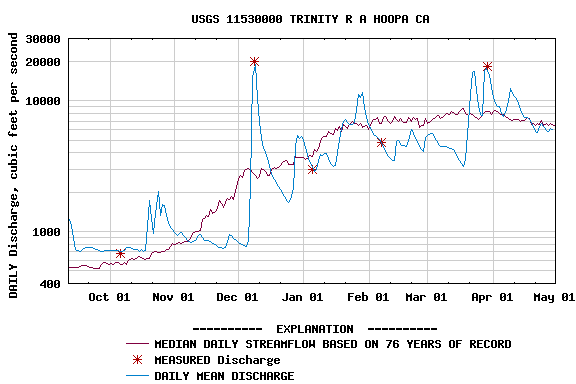
Our Klamath Basin Water Crisis
Upholding rural Americans' rights to grow food,
own property, and caretake our wildlife and natural resources.

Our Klamath Basin
Water Crisis
Upholding rural Americans' rights to grow food,
own property, and caretake our wildlife and natural resources.
|
Following message (before the article) by Barb
Hall, Klamath Bucket Brigade.
You have to really read this article to get the true meaning. The reporter makes it sound like the Trinity flows have been real low all winter. Not the truth!
I've placed the USGS
last 30 day flow chart for the Trinity at Hoopa,
CA below and one for the past 230 days. If the
Bureau is hoping to clean out the gravel beds and
help the spring smolts get out to the ocean, they
didn't consider the flows at the beginning of
April. Talk about a flood! And the statement
that the flows haven't been over 300 cfs since
October is releases from Lewiston, not the flow at
the mouth. Flows at the mouth hit 20,000 cfs in
early December 2005. One thing these graphs do
prove is that the Trinity watershed gets lots of
winter rain and all that water is wasted going out
the mouth of the Klamath River. (If the graphs
didn't come through for you, just click on the
links and you'll go to them on the USGS and the CA
gov water sites) ~ Barb
Trinity flows to hit 4-decade high
Agency won't save water to prevent another big fish kill By Alex Breitler,
Record Searchlight TRINITY RIVER -- Get ready for a new Trinity River. Flows downriver in the coming weeks should be the highest since Trinity Dam was built more than 40 years ago, as a Clinton-era restoration plan is put into place after years of litigation. The Bureau of Reclamation decided against saving some of the Trinity's water to send downstream in the fall to prevent another fish kill on the lower Klamath River. Instead, the vast majority of the water will be released in May, June and July, giving the Trinity strong currents that it hasn't had in decades, with the exception of flood years. Flows have stayed around 300 cubic feet per second (cfs) since October. By today, they should crank up to 2,000 cfs and by May 10 should peak at 7,000 cfs.
At that level, the water will be so high that just 12 seconds of flow would be enough to supply the towns of Weaverville and Douglas City for one day. The flows will remain at 7,000 cfs for four days before slowly dropping back down. Until this year, flows have been limited to 6,000 cfs. In future years, they could go a lot higher -- up to 11,000 cfs in very wet seasons. Ecologically, the idea is to scour clean the river's gravel beds and flush juvenile salmon out toward the ocean. The flows might also be good news for rafters. But those who are used to a tame Trinity had better beware, the bureau warns. "That's an awful lot of water," said bureau spokesman Jeff McCracken. "It's going to be moving very fast, and it's going to be very cold." Department of Interior officials created a controversy earlier this month when they asked an advisory council to consider holding back some water to help adult salmon swimming upstream in the fall. In 2002, at least 33,000 of those fish died on the lower Klamath below its merger with Trinity due in part to low flows. Trinity River advocates struck back, saying the proposal would ignore years of scientific study and would "prostitute" the Trinity for political purposes. The advisory council rejected the fall flows, and the bureau published a flow schedule that supporters say is much closer to the vision of the original restoration plan. Historically, the majority of the Trinity's water has been diverted to farms in the Central Valley. The restoration plan was challenged in court but ultimately upheld last year. Crews are rebuilding or strengthening four bridges to withstand higher flows, and one home eventually will have to be moved. Rafters are gearing up for what the Trinity River Rafting Co. on its Web site calls "exceptional flows." Marc Rowley of the Bigfoot Rafting Co. in Willow Creek says the higher flows are good for business. But the swift currents are probably best for those with experience, Rowley said. Flows at 7,000 cfs are the equivalent of 52,500 gallons per second shooting through the channel. "It's got to be the right group of rafters," he said. "It's certainly not for average family travelers. The rapids can get quite turbulent." Reporter Alex Breitler can be reached at 225-8344 or at abreitler@redding.com.
USGS Real-Time Water Data for USGS 11530000 TRINITY R A HOOPA CA

|
||||||
Home
Page Updated: Thursday May 07, 2009 09:14 AM Pacific
Copyright © klamathbasincrisis.org, 2005, All Rights Reserved